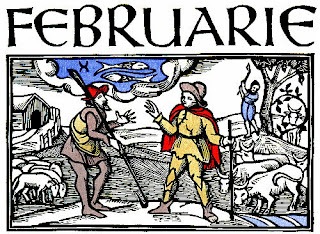It is also the month most often mispronounced, with the
initial ‘r’ causing a lot of trouble. There is something called the dissimilation effect, which explains the fact that having two ‘r’s so close together in a
word causes us to drop the pronunciation of one of them as we speak (think of
surprise, or particular for instance). This is why we sometimes hear February
being called ‘Febuary’, like its January neighbour.
Incidentally both these months share name roots with two
ancient Roman gods; January Being Janus (that’s right, the god of doors), and
February being Februu. Though actually the god Februu was named after a
purification ceremony that took place at that time of the year. I find it
interesting that the Romans explicitly named their gods after things that
already existed, such as festivals, or concepts. Seems a much more human way of
making a religion.
 |
| Janus also had two faces, one to look back and the other forward; which makes sense as the first month of the year I suppose. Looking back at the previous year, looking forward to the new year. |
Anyhow, odd though February may be, looking into its history
actually helps explain why our calendar looks the way it does today, and solves
a little quirk involving the months names that used to annoy me as a child.
Way back prior to 713 BCE, before Jesus was invented, the
Roman calendar was based on the lunar cycle, so that every month had around 30/31 days. It was a ten month calendar, with roughly each month being named in the
Roman fashion for its position throughout the year. Hence back then the fifth
month was called Quintilis (literally Latin for fifth), and the sixth was
Sextilis (later to become August, the best month), ‘sept’ for seven made September, ‘oct’ for
eight: October, and so on up to December.
I remember noticing this as a kid and being confused as to
why the numbering order was out of sync with the months place in the year.
Well it turns out that back when this roman lunar calendar
was being used, there were only ten months in a year, and they were named and
set out as such:
Martius (31 days), Aprilis (30 days), Maius (31 days), Iunius (30 days), Quintilis (31 days), Sextilis (30 days), September (30 days), October (31 days), November (30 days), December (30 days).
The more astute of readers might have noticed that this
leaves us with a year only 304 days long. It turns out that the Romans didn’t
consider the winter season as having any months at all, and so when the month of
December came to an end, the calendar simply stopped and waited until the
winter season broke, and Martius (March) could begin.
Then King of Rome, Numa Pompilius, put a stop to this
practise by adding in two 26 day months at the end of the year; and here is
where we find the beginning of January, and February.
Around two-hundred and sixty years later the start of the
year was moved from March to January, and the length of the months altered so
that January began to resemble a more normal month, while February was doomed
to forever be the odd month out, accounting for the sloppy ellipse our planet
makes around the sun each year (why didnt the gods just make a more evenly divided circuit of the sun?).
And so February moved from being a disjointed time of the
year, to the end of the year, and now to its current spot as the second month
of the year. It started off as no days, was born with 26 days, fluctuated for a
while from 23, to 27 and even 30 days before settling on its four year
oscillation from 28 to 29 days.
On a leap year it is the only month that ends on the same
day of the week that it began, which just has to be true, because it’s on
Wikipedia.
Though it is named after a ritual that we no longer practice, perhaps we should think ourselves lucky that February didn’t retain its old
English name of Solmonath, which described it as the mud month, or the curious
Kale-monath, which proclaimed it the month of cabbage.
There are languages whose names for February stem from nicer
etymologies, such as the Finnish name helmikuu. This translates to the month of
the pearl, and describes the frozen droplets that form on trees around that
time of year in Finland. The Polish and Ukrainian languages likewise refer to
the obvious season properties in that region, where they call February Luty or
лютий, meaning the month of ice or hard frost.
 |
| Cabbage; great for Chow Mein, not so great for naming months after. |
Luckily us English speakers from the southern hemisphere can
focus on our defunct Roman ritual based month, instead of having to reside in a
month named after cold, when the time of year can be anything but.
February also has some interesting anniversaries in it:
National No-Bathroom Month [sic] (whatever that means)
Groundhog Day: February 2
Abraham Lincoln's birthday: February 12 (More importantly Darwin Day, as the great naturalist was born on the same day in history as the great emancipator)
Liberation Day (Kuwait) February 26 (Really?)
National Wear Red Day………..
I for one celebrated Groundhog Day with a
re-watch of the Bill Murray classic.
And with that I end my little post on the shortest month of the year; I hope it was in some way enlightening for you.
Cheers.
MM
 |
| "I would love to stay here and talk with you... But I'm not going to ......." - Phil Connors |
Cheers.
MM

.svg.png)
No comments:
Post a Comment